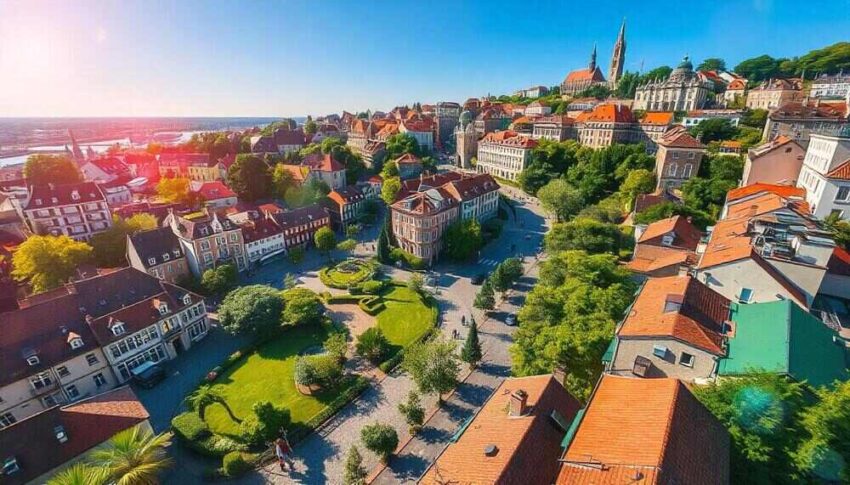Fashion
What’s Driving Eastern Europe’s Fashion-Tech Boom?

In 2008, the year Milda Mitkute co-founded fashion resale marketplace Vinted with Justas Janauskas in Vilnius, Lithuania, the country’s start-up scene was basically non-existent.
“I call it the wild, wild West in Lithuania,” Mitkute said. “It was like zero start-ups at that time.”
Vinted was among the first. In its early years, the company operated as a hobby project for Mitkute and Janauskas, who held down regular jobs while working on Vinted on the side. Janauskas did all the web development alone. After three years, during which the company had opened sites in markets like Germany, it needed to hire its first developer. The role wasn’t easy to recruit, Mitkute said. People felt ashamed admitting they worked for a start-up rather than a big corporation.
Today the situation is different. Since becoming the first Lithuanian company to capture a $1-billion valuation in 2019, Vinted has embarked on an acquisition spree, opened operations in several countries including Italy and Canada, and swung into profit. Mitkute, who stepped back from the company after having her first child several years ago, is now an angel investor in Lithuania’s start-up ecosystem, which she said is bustling and attracting global venture-capital firms looking for exciting opportunities.
The Central and Eastern European region has emerged as a hotbed for fashion-tech businesses in recent years, producing a number of start-ups serving both local and overseas markets. Vinted is an especially successful example, but also from Lithuania is Wanna, the augmented-reality and virtual try-on provider that has worked with brands like Gucci and was acquired by Farfetch in 2022.
Estonia has produced businesses including Alpha AR, which uses 3D modelling to create content for AR and try-on experiences, and Fits.me, a virtual fitting company bought by Japan’s Rakuten in 2015. Beyond the Baltic states in the wider region, The Nold, a resale marketplace that recently expanded to the UK, originated in Bulgaria, as did Remix, another resale player that ThredUp purchased in 2021. That’s just to name a few.
“The growth has been wild,” said Krista Jegorova, who was a project manager at the Baltic Fashion Federation and the Investment and Development Agency of Latvia in Riga before relocating to Spain last year. “Now every second Latvian has a start-up.”
A number of those start-ups are fashion-tech companies that have been lifted by the bigger technology boom reshaping the region. Today, Central and Eastern Europe has more information and communications technology enterprises per 1,000 inhabitants than Western Europe, according to an April report from PwC Poland and the CEE Digital Coalition. While the region’s economic productivity still lags its Western counterpart, it punches well above its weight in tech talent.
Even though most fashion markets in Eastern Europe are less developed than those in Western Europe, the region is very fashion-conscious. People place a particularly high value on their appearance, said Boryana Uzunova, co-founder of The Nold.
That environment is helping to spur the growth of fashion-tech companies, which are having an impact beyond their home markets.
“Tech-wise, we are very happy and very lucky to be located exactly where we are, because we have at our disposal all of this power that we can utilise,” said Ana Kremenlieva, another of The Nold’s co-founders along with Uzunova and Teodor Savov, the company’s chief technology officer.
Last year, the company raised €1 million ($1.1 million) in seed funding from a consortium of investors from their home country of Bulgaria and Czechia. It got its start, however, in Sofia in 2021 after Uzunova recognised the need for a resale marketplace where customers could list their clothing. Initially it had some difficulty persuading investors to fund the project, but finding developers was never a problem. Savov “got a very capable team in no time and we started to build our dream platform,” Kremenlieva said.
Cause and Effect
The tech explosion in Central and Eastern Europe that has benefited The Nold and others was brought on by a variety of factors, according to Pawel Oleszczuk and Julia Otwinowska, senior advisory manager and senior advisory associate respectively for PwC Poland. A strong macroeconomic environment with GDP growth outpacing Western Europe provided fertile ground for businesses to flourish. Accession to the EU for several countries in 2004 contributed to economic growth, created stability and opened the door to institutional reforms.
“Our transition from a socialist to capitalist economy, which started in the ‘90s, was a starting point to the development of the ICT (information and communications technology) sector, but what was really a turning point was our EU accession,” said Otwinowska. It helped boost confidence in the region, leading to more foreign investment.

What’s more, an education system that emphasised STEM (science, technology, engineering, and mathematics) topics — a holdover from the Soviet era when Moscow held sway over many countries in the region through the Eastern Bloc alignment — provided a talent pool with the right skillset. And the region built up a good digital infrastructure, offering widespread access to high-speed internet. This environment and low labour costs compared to Western Europe have attracted foreign businesses looking for IT services.
Growth of the tech industry hasn’t been evenly distributed across the region. Some countries are racing ahead while others are taking longer to get up to speed. Either way, these ingredients have created the right conditions for the region to wield outsized influence.
Estonia, for instance, has fewer than 2 million people, “so relatively small,” Oleszczuk said, “but Estonia has one of the highest numbers of [start-up] unicorns.” Successes from the country include mobility start-up Bolt, and Estonian developers were part of Skype’s founding team.
Ukraine and Russia, the two giants of the region, have enjoyed similar advantages, though their paths have been slightly different as they’ve remained outside the EU. And both countries have felt the impact of Russia’s invasion of Ukraine.
Sanctions on Russia have constrained the country’s digital sector, while tech talent from each has fled to other locations. Many Russians have gone to countries where they can enter without a visa, such as Georgia and the United Arab Emirates. Ukrainians have gone to places like neighbouring Poland, a strong tech player and home to fashion-focused start-ups such as virtual try-on provider Wearfits and Fitly.ai, which uses AI for fit recommendations.
Ukraine in particular had a strong fashion-tech sector that produced companies such as 3DLook, a leader in virtual try-on; founders like DressX’s Daria Shapovalova and Natalia Modenova; as well as engineering staff for many others. They’ve had to adapt to the war, which could have long-lasting effects. Ukraine also applied for EU membership in June 2022 after its invasion by Russia and formal talks are expected to begin Tuesday.
The Soviet legacy in Central and Eastern Europe may have shaped entrepreneurship in the region in other important ways, too. Under the Soviets, freedoms were restricted and opportunities scarce. After the countries became independent, everything suddenly changed.
Vinted’s Mitkute said it produced a sense of “eagerness and I would say feeling hungry — for new ideas, for new things … it was being hungry to create because you don’t have a good life, so you need to build [it] yourself.”
More to Come
That hunger is evident across Eastern Europe, which along with fashion-tech entrepreneurs, is producing a number of globally renowned design talents, including names like Kiko Kostadinov (Bulgarian), Anna October (Ukrainian), Sandra Sándor (the Hungarian founder of Nanushka), Nensi Dojaka (Albanian) and Demna Gvasalia (the Georgian artistic director of Balenciaga).

That mix of fashion and tech talent is likely to keep the fashion-tech sector flourishing, as is the ongoing explosion of tech ambition in the region more broadly and the influx of venture capital funding it. Bain & Company found that VC investment in Central and Eastern Europe increased more than nine times over from 2015 to 2021, the fastest rate for any region in Europe. “CEE has arrived on the map of European venture capital, and the growth streak is set to continue,” it stated.
That trajectory isn’t guaranteed. PwC’s Oleszczuk pointed out that economic headwinds caused by unexpected geopolitical events like the war in Ukraine, regulatory constraints and other shifts, such as rising labour costs, can have an effect. In 2023, for instance, the region did see a drop in venture capital in line with falling investment across Europe.
But for now, the years ahead look bright. Online resale marketplaces, AR companies and now artificial intelligence plays are among those gaining strength. Jegorova, the former project manager at the Baltic Fashion Federation, said there’s a strong sense of community among the companies, who all help one another. Governments are also helping by providing grants and education to entrepreneurs. In her view, the region’s rise is only beginning.
“We started maybe later than others, but we are growing so fast,” she said. “You’re going to see so much more in a few years.”










